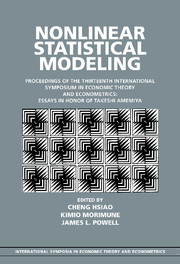 Nonlinear Statistical Modeling
Nonlinear Statistical Modeling Book contents
- Frontmatter
- Contents
- Series editor's introduction
- Editors' introduction
- Contributors
- 1 Local instrumental variables
- 2 Empirically relevant power comparisons for limited-dependent-variable models
- 3 Simulation estimation of polychotomous-choice sample selection models
- 4 A new approach to the attrition problem in longitudinal studies
- 5 Semiparametric estimation for left-censored duration models
- 6 Semiparametric estimation of censored selection models
- 7 Studentization in Edgeworth expansions for estimates of semiparametric index models
- 8 Nonparametric identification under response-based sampling
- 9 On selecting regression variables to maximize their significance
- 10 Using information on the moments of disturbances to increase the efficiency of estimation
- 11 Minimal conditions for weak convergence of the sample standardized spectral distribution function
- 12 Unit root tests for time series with a structural break when the break point is known
- 13 Power comparisons of the discontinuous trend unit root tests
- 14 On the simultaneous switching autoregressive model
- 15 Some econometrics of scarring
- 16 A censored switching regression approach to evaluating the effect of sunk costs and firm-level disequilibrium on export performance
- Curriculum vitae of Takeshi Amemiya
- Index
16 - A censored switching regression approach to evaluating the effect of sunk costs and firm-level disequilibrium on export performance
Published online by Cambridge University Press: 05 June 2012
- Frontmatter
- Contents
- Series editor's introduction
- Editors' introduction
- Contributors
- 1 Local instrumental variables
- 2 Empirically relevant power comparisons for limited-dependent-variable models
- 3 Simulation estimation of polychotomous-choice sample selection models
- 4 A new approach to the attrition problem in longitudinal studies
- 5 Semiparametric estimation for left-censored duration models
- 6 Semiparametric estimation of censored selection models
- 7 Studentization in Edgeworth expansions for estimates of semiparametric index models
- 8 Nonparametric identification under response-based sampling
- 9 On selecting regression variables to maximize their significance
- 10 Using information on the moments of disturbances to increase the efficiency of estimation
- 11 Minimal conditions for weak convergence of the sample standardized spectral distribution function
- 12 Unit root tests for time series with a structural break when the break point is known
- 13 Power comparisons of the discontinuous trend unit root tests
- 14 On the simultaneous switching autoregressive model
- 15 Some econometrics of scarring
- 16 A censored switching regression approach to evaluating the effect of sunk costs and firm-level disequilibrium on export performance
- Curriculum vitae of Takeshi Amemiya
- Index
Summary
Introduction
Despite ever increasing recognition of the importance of manufacturers' exports to economic growth, economists have been nearly silent on the effectiveness of various specific export promotion policies and on how their effectiveness might vary across enterprises according to the relative importance of different constraints which these firms face. Indeed, trade models use equilibrium models and typically ignore firm-level variables in order to concentrate on macro- or industry-level factors such as exchange rates, tariff rates, and other general types of policies.
Recently, however, several papers analyzing firm behavior among both exporters and nonexporters have begun to emerge. For example, Bernard and Jensen (1995a,b, 1996, 1997) found significant differences between exporters and nonexporters among US manufacturing plants. Similar differences have been observed among the firms in other countries, especially in developing countries where the interest is greatest (Roberts and Tybout 1997 for Colombia; Aw and Batra 1994 for Taiwan; Aitken, Hanson, and Harrison 1997 for Mexico, and Bernard and Wagner 1997 for Germany). In particular, Aitken, Hanson, and Harrison (1997) provided evidence that plant size, wages, and especially foreign ownership are positively related to the decision to export. They also examined whether spillovers associated with one firm's export activity reduced the cost of exporting for other firms, and then found evidence of spillovers from multinational enterprises but not from general export activity. Roberts and Tybout (1997) showed that in the presence of sunk costs, a firm's prior export experience as well as some plant characteristics, such as size of capital, plant age, and ownership structure, are positively related to the propensity to export.
Information
- Type
- Chapter
- Information
- Nonlinear Statistical ModelingProceedings of the Thirteenth International Symposium in Economic Theory and Econometrics: Essays in Honor of Takeshi Amemiya, pp. 403 - 440Publisher: Cambridge University PressPrint publication year: 2001